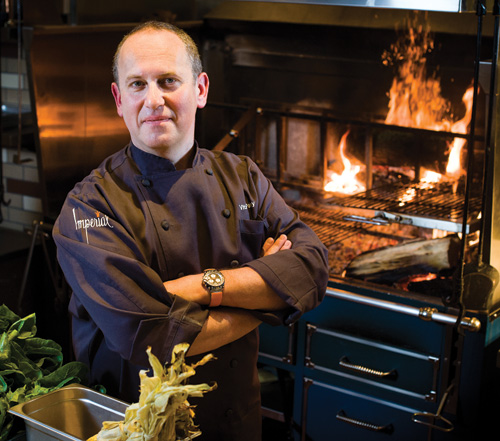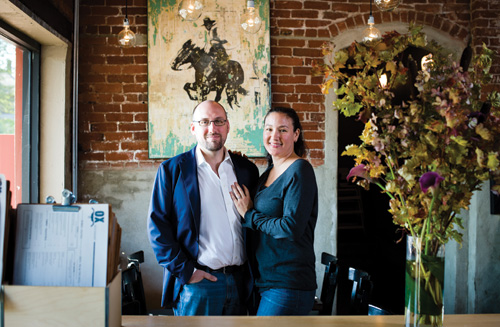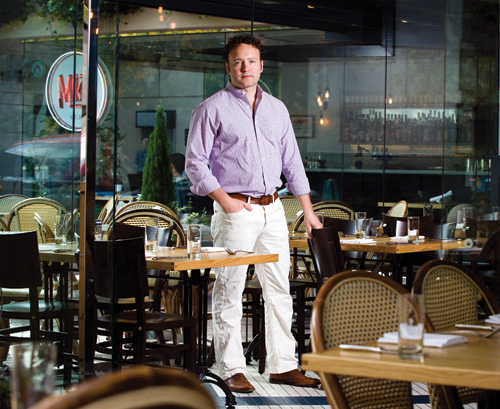 Affordable homes, good schools, cheap liquor licenses and funky neighborhoods are the ingredients for the city’s booming restaurant industry.
Affordable homes, good schools, cheap liquor licenses and funky neighborhoods are the ingredients for the city’s booming restaurant industry.
BY LINDA BAKER
 |
“When I opened Paley’s in 1995, Northwest Portland was the ‘it’ place to be,” says chef Vitaly Paley, who recently opened Imperial, his second restaurant. “Then it was the East Side, and now it’s downtown. We all gravitate toward one another. The more the merrier.”// Photo by Leah Nash |
In 2010 Thomas Boyce, an acclaimed chef who worked at Spago in Beverly Hills for 13 years, decided to relocate to Portland, where he serves as chef at Bluehour in the Pearl District. Boyce, who has three young children, says he and his wife decided on Portland because of the city’s family-friendly lifestyle. “We thought of schools in Los Angeles and said, ‘It’s time for us to make a move.’” Portland’s lively and accessible restaurant scene was another attraction. Restaurants succeed in places that get national exposure, Boyce says, “and Portland is getting a lot of exposure.” Boyce says starting a new restaurant in Los Angeles costs at least $1.5 million. “In Portland I saw places where the space was $50,000 and the build out $50,000. That’s what excited me.”
Boyce is not alone in his enthusiasm for Portland restaurants. By almost any metric, the local dining scene is sizzling. New restaurants seem to open every month, and the city’s independent restaurants, from low end to high, are featured regularly on the pages of The New York Times and national food magazines such as Bon Appétit. Eighteen years after chefs such as Greg Higgins and Cory Schreiber helped pioneer a local farm-to-table cuisine, the industry is undergoing yet another wave of growth, characterized by relocation of top talent such as Boyce, a wave of second ventures by established local chefs and a shift to downtown as a culinary destination.
“In covering the national food scene, it’s gotten so I have to come to Portland four times a year just to keep up with what’s going on,” says Bon Appétit restaurant editor Andrew Knowlton. In the magazine’s September issue, Knowlton ran two stories about Portland dining venues: one about the restaurant Luce, the other a guide to ethnic dining.
In a city still recovering from the recession, the local dining boom raises questions about how many restaurants Portland can actually sustain, and just who are all those people tucking into caprese salad and so many kinds of pork belly. But given the national spotlight, there is a bigger question: How did the Rose City become the leader of a nationwide culinary renaissance? Many cities on the West Coast — and in many parts of the country — have the same bounty of beer, wine, meat and produce, and, in the case of Seattle, more direct access to seafood.
If Boyce’s story is any indication, the answers revolve around a number of economic factors, ranging from cheap real estate that makes it easy for young chefs to open their own restaurants, to a host of urban amenities such as solid public schools that help attract and retain top talent. Culinary tourism, public policies supporting dense, walkable neighborhoods and favorable regulations, such as cheap liquor licenses, are also helping fuel the industry’s growth.
Restaurateur Kurt Huffman stands in Market, a downtown Portland restaurant he opened this past July. “The thesis is too self-congratulatory; it’s too easy to say that chefs were somehow attracted to the bounty of Oregon and cooked all this amazing stuff,” says Huffman. “I just don’t buy that as the driver of why the food scene happened here.”// Photo by Leah Nash |
In other words, understanding the evolution of Portland’s food scene requires a bit of contrarian thinking. The reasons Portland has been able to incubate a successful restaurant industry may have as much to do with the city’s social, economic and urban development circumstances as it does the chefs and the food. In 2012 Oregon had 10,500 restaurants that employed about 170,000 people and were projected to register $6.2 billion in sales, up from $5.3 billion in 2007. In Portland, data about the numbers of restaurants is a bit harder to come by, despite the often repeated statement that Portland has more restaurants per capita than any other city in the country. “I’ve never been able to verify that claim,” says John Hamilton, a spokesperson for the Oregon Restaurant & Lodging Association. An increase in liquor license applications does point to an uptick in new restaurant openings, Hamilton says, and in Portland, anecdotal evidence bears out that claim.
At least 15 new chef-driven independent restaurants have opened or will open in inner-city Portland this year, many hotly anticipated second ventures from local restaurant owners. John Gorham, proprietor of the popular Tasty n Sons on North Williams Avenue, is opening a second location downtown this fall. Tommy Habetz, chef/co-owner of Bunk Sandwiches, is opening the Tex-Mex-themed Trigger in Northeast Portland, also this fall.
“The number of new restaurants is multiplying; it feels like it’s squared every year,” says Nostrana co-owner Cathy Whims, who opened a second restaurant herself this past fall, the Pearl District’s Oven & Shaker. She used to worry that new restaurants would cut into her bottom line. Instead, the uptick in new restaurants seems to be having a cluster effect. “They just bring new business,” she says.
One of the most high-profile openings of the year is Imperial, a new venture in the Hotel Lucia by acclaimed chef Vitaly Paley, who has run the award-winning Paley’s Place since 1995. “I felt the need to express other creative thoughts and ideas,” says Paley. But Paley also got a good deal from the owners of the downtown hotel, who approached him with the idea about a year ago and, he says, contributed the lion’s share of the funding.
In Portland restaurant circles, relatively propitious real estate is a common topic of conversation, especially among those who have relocated from higher-priced cities. In 2010 Andrew Fortgang and Gabriel Rucker, co-owners of Le Pigeon in Southeast Portland, opened a second restaurant downtown, Little Bird, for about $300,000. “To open the same restaurant in New York would be a million and a half, maybe two,” says Fortgang, 33, who worked in Big Apple venues before moving to Portland in 2007. Then there’s Johanna Ware, who served as sous chef for New York City’s Momofuku restaurants before moving to Portland in 2009 and eventually opening Smallwares, a new restaurant in Northeast Portland. “I knew it would be a little easier and cheaper to do it in Portland,” says Ware, who, with the help of her mother spent about $150,000 to open the Asian-influenced venue.
Unlike Chicago, San Francisco or even Seattle, Portland restaurants tend to be guided by the vision of an individual chef/owner, not a pool of investors. Along with the artisan coffee, beer, wine and farms, the image of the artisan chef is part of a “sexy, super-appealing story” explaining how Portland became a culinary mecca, says David Machado, proprietor of Nel Centro and Vindalho.
But it’s not the whole story. Unlike other cities, Portland’s relatively affordable housing allows startup owners and staff “to live in harmony with their wage,” says Machado. Oregon’s minimum wage is $8.80 an hour; California’s is $8. As of September 2012, a two-bedroom Portland apartment rented for an average of $1,032 a month, compared to $2,106 a month in San Francisco. The role Portland’s famed livability has played in nurturing the restaurant industry cannot be overstated, he says.
“Sixteen years ago, I moved to Portland from San Francisco to open a restaurant, buy a home and put my kids in public schools,” he says. “To this day, if you talk to [a chef] who moves here, they would probably tell you the same thing.” Machado pauses. “Those are good goals,” he says. “Good ideals.”
 |
This past April, Gabrielle Quiñónez Denton and Greg Denton opened Ox, an Argentine-inspired restaurant on NE Martin Luther King Jr. Boulevard in Portland. The restaurants Toro Bravo and Trigger are nearby. “We knew there was plenty of room for another restaurant and even more restaurants to come,” says Greg.//Photo by Leah Nash |
On a Monday afternoon in September, Kurt Huffman is eating an heirloom tomato salad at Imperial, one week after the restaurant has opened. The owner of ChefStable, a restaurant incubator and investment group, Huffman has a stake in some of the city’s most talked-about venues: Ox, Lardo, St. Jack, Ping and Grüner. Not all have been successful. In September, one of his venues, Corazón, located in the Twelve West building downtown, closed after three months.
“The labor model was completely out of whack,” says Huffman, noting that Corazón, which tried at once to be a high-end Mexican restaurant and also do $3 tacos, ground its own masa for tortillas and hand-diced the salsa. Even in a DIY food city, there are limits. Huffman observes. “Nobody hand-cuts their own salsa. That’s ridiculous.”
For restaurants, labor is typically the biggest cost and the most difficult to manage. Unlike most states, restaurant owners in Oregon are also prevented from factoring in tips as part of staff pay, which can add to labor expenses. The absence of a so-called “tip credit” law means an Applebee’s in Florida can net about 7% more than an Applebee’s in Oregon, says Huffman. Although independents and chains alike are affected, chains typically factor the tip credit into their business model, says ORLA’s Hamilton. It’s one reason why Oregon is home to more single-owner operators and fewer chain restaurants than other states.
Tip credit aside, Huffman says Portland’s food and beverage regulations are generally favorable to the industry and are key to understanding why so many people open restaurants in Portland. Like many proprietors, Huffman singles out as particularly important the low cost and relative ease of obtaining a liquor license. In Portland, an annual license runs about $400 a year. In Boston, a private sale license costs about $40,000; in Idaho, $70,000.
“They give them to almost everybody,” says Huffman, referring to Oregon licenses. “All you have to do is have food alternatives.” Portland also has among the most permissive regulations in the country for opening a food cart. And, of course, there’s no sales tax in Oregon, a factor that helps sustain local restaurants.
The city and state help boost the industry in other ways. Capitalizing on a nationwide food renaissance that has been under way for years, Oregon Tourism Commission offices are championing culinary tourism, with specific campaigns touting Portland’s independent restaurants. For the past eight years, for example, Travel Oregon has run an “Oregon Bounty” advertising campaign, featuring chefs and other food professionals from around the state. More recently, 66 restaurants participated in Dining Month, a Travel Portland campaign that offered three-course meals for $25. Multiple restaurants saw record-breaking sales, and a follow-up survey suggested that about 30% of diners were tourists, says Courtney Ries, consumer marketing manager for Travel Portland.
In a city lacking major tourist attractions, individual restaurants have already developed an out-of-town following. Naomi Pomeroy, the chef/owner of Beast, a high-end, fixed-price, French-inspired restaurant, says about 75% of her customers are from elsewhere. Recently, a couple celebrating their 18th anniversary flew in from Chicago just to eat at the restaurant.
Beast is located in a restaurant cluster in the NE Killingsworth neighborhood, one of many community restaurant districts that tell another story about the rise of Portland dining. Or, as Pomeroy puts it: “Part of Portland food culture is people want to go see those cute little neighborhoods.”
So closely entwined are Portland neighborhoods and restaurants that the story of the industry’s boom could be written as a narrative of local neighborhoods, a narrative in which new restaurants serve as a catalyst for neighborhood revitalization, which in turn attracts more restaurants and customers.
That virtuous cycle has been fueled in part by the Portland Development Commission investing substantially in the local industry. Between 2007 and 2012, the city agency loaned about $1.8 million to 22 dining establishments, including $50,000 for Grüner and $60,000 for Bunk Bar. Private-sector developments are also playing a role. Historically, developers have shied away from restaurants, mainly because banks consider them high risk, says Kevin Cavenaugh, a local developer. He recently completed Ocean, a $1.6 million “micro-restaurant” complex in Northeast Portland featuring food-cartstyle venues from some of the city’s leading restaurateurs. Portland builders are at the forefront of recognizing the value of dining establishments as tenants, he says. “I can think of no better way to give a building instant pop than adding a restaurant.”
That pop is well understood in the hotel industry, says Machado, who, a few years before the opening of Imperial, inked a beneficial deal with the owners of the Hotel Modera that made Nel Centro the house restaurant. Over the years, the onus of quality has shifted from the hotel to the hotel restaurant, he says. “It used to be ‘A’ hotel and ‘B’ restaurant. Now it’s ‘B’ hotel and ‘A’ restaurant. It has to do with the business traveler, who is looking for conviviality, action, quality in where they’re staying.”
Making money: “We don’t talk about that” |
Portland restaurants are springing up everywhere. But are they making money? A few Portland chefs/owners were forthcoming about revenues — to a degree. According to co-owner Andrew Fortgang, Little Bird grosses about $2.5 million annually and Le Pigeon about $1.5 million. In 2011 Nostrana grossed about $2.8 million, with expenses of about $2.6 million, owner Cathy Whims says. At Paley’s Place, over the past 10 years revenue has grown 30% annually, owner Vitaly Paley says. Among local indie chefs, it’s “almost taboo” to talk about profit, says Kurt Huffman, owner of ChefStable, an investment group with a stake in restaurants such as Ox, Ping and Grüner. “Corporate restaurants are the ones that make a lot of money,” he says. “But there’s the idea that we’re artists; we don’t talk about that.” Independent restaurants generally net 4% to 6%, although many aim for a 10% to 15% profit margin, Huffman says. His group of ChefStable restaurants nets anywhere from 3% at the poorest-performing venue — “It’s not the restaurant people think it is,” he says — to 20% at the best-performing. Compared to other cities, opening a restaurant in Portland is more of a lifestyle than financial decision, says Bruce Carey, whose five restaurants in Portland — Bluehour, 23Hoyt, Clarklewis, Saucebox, Via Tribunali — “eke out” a 10% profit margin. Most independent owners are content making less than they could if they were in Los Angeles or Chicago, he says. “If you keep your expectations in check for what you will take home, opening your own small, chef-driven, owner-operated restaurant provides an acceptable quality of life,” Carey says. “But it ain’t no get-rich-quick scheme for anyone.” |
That paradigm is leading to a more favorable real-estate climate for restaurant owners and helps explain the Portland miniboom in hotel restaurants owned by local chefs.
This past September, thousands of people from around Oregon, the country and the world descended on the Rose City for Feast Portland, an international culinary festival celebrating “Oregon bounty.” It was another feather in the cap for a metropolis Knowlton says is one of the three “most exciting food cities” in the country right now. The ranking is based on new restaurant openings, “buzz” and eagerness on the part of top chefs to visit Portland.
Echoing the assessment of many local chefs and critics, Knowlton says the food in Portland restaurants isn’t better than in other cities, and that the city suffers from a lack of high-end, avant-garde options. There is also “a bit of a cookie-cutter mentality” in the replication of dishes and atmosphere, he says.
Food criticism notwithstanding, Portland dining stands out for its “complete package,” Knowlton says, from the independent chef/owners to the spirits, coffee, beer, “cool neighborhoods” — and the bicycles. “It’s a zeitgeist. It’s the Brooklynization of America.”
Fueled by a disparate collection of regulations, urban development policies, real-estate trends and that amazing bounty, Portland restaurants have become an international sensation. All that attention will raise the bar for the cuisine, says Boyce, whose wife, baker Kim Boyce, has opened up her own shop. “People came here because of the scene, and now the scene will expand and grow because of that,” he says.
Mike Thelin, co-founder of Feast Portland, gets to the root ingredient of why Portland is a restaurant leader. “Societally, right now food is the hottest thing,” he says. “And Portland is the hottest city.”
Linda Baker is the managing editor of Oregon Business. She can be reached at [email protected].




